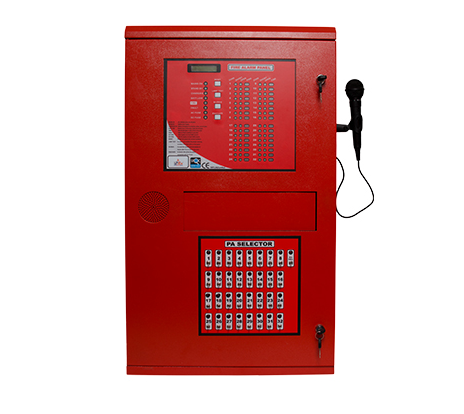Public Addressable Systems

Public Addressable Systems
The Importance of Public Addressable Systems in Firefighting
Firefighting and fire safety protocols are critical to ensuring the safety of individuals and property in the event of a fire. When a fire occurs, quick communication and coordination are essential to minimize damage and loss of life. Public Addressable Systems (PAS) play a crucial role in fire safety by providing clear, real-time communication to guide individuals during an emergency. These systems are integrated with fire alarm systems to enhance evacuation procedures and support emergency management efforts. In this article, we will explore the importance of Public Addressable Systems for firefighting, their components, and how they contribute to effective fire safety management. We will also discuss why Angel Safety Consultants is the ideal partner for implementing such systems.
What is a Public Addressable System (PAS)?
A Public Addressable System is a type of fire alarm and emergency communication system that allows for two-way communication between the control panel and speakers placed throughout a building or facility. In the event of a fire or emergency, a PAS can deliver real-time voice messages, alerts, and instructions to guide occupants to safety. Unlike standard fire alarms that simply trigger audible alarms, PAS provides more detailed, actionable information by broadcasting live or pre-recorded messages that direct people to evacuation routes, safe zones, and other critical instructions.
These systems are particularly beneficial in large buildings, industrial sites, hospitals, schools, and shopping malls, where the complexity and size of the space make it difficult for everyone to hear or understand the standard fire alarm signal.
Key Components of Public Addressable Systems
A well-designed Public Addressable System consists of several key components that work together to ensure effective communication during emergencies:
1. Control Panel :
The control panel is the heart of the PAS. It serves as the main interface for operators to monitor and manage the system. It receives input from the fire alarm system and activates voice messages when needed. The panel also allows for manual intervention, enabling operators to send custom messages or override automated announcements.
2. Speakers :
Speakers are strategically installed throughout the building to broadcast fire alarms, evacuation instructions, and emergency information. They are typically placed in hallways, stairwells, lobbies, and other high-traffic areas where occupants are likely to hear them.
3. Microphones :
In some systems, microphones are available for real-time announcements. This allows authorized personnel to communicate directly with building occupants, providing updated information as the situation unfolds.
4. Amplifiers :
Amplifiers are used to boost the sound of the messages, ensuring that the sound reaches all areas of the building, especially in large or noisy environments. The amplifiers ensure that the sound is loud enough to be heard over ambient noise, including machinery or HVAC systems.
5. Emergency Power Supply :
To ensure the system remains operational during a power outage or after a fire disrupts power supplies, PAS systems are typically equipped with a backup power supply. This may include batteries or generators that allow the system to continue functioning even if primary power sources are unavailable.
6. Zoning :
Zoning is a feature that allows messages to be broadcasted only to specific areas of the building. This is especially important in larger facilities, where fire or emergency events may only affect a localized area. Zoning helps to ensure that people in unaffected parts of the building can continue their normal activities without unnecessary panic.
How Public Addressable Systems Support Firefighting
In the context of firefighting, Public Addressable Systems are indispensable for the following reasons:
1. Clear Communication During Emergencies :
In the event of a fire, clear and timely communication is essential. Public Addressable Systems provide real-time information to building occupants, telling them when to evacuate, which routes to take, and which areas to avoid. This reduces confusion and panic, allowing for a smooth and orderly evacuation.
2. Guided Evacuation :
Fire alarms are often insufficient to guide people through a building, especially in large or complex spaces. With a PAS, evacuation instructions can be tailored to different building zones, ensuring that individuals know the safest routes and exits. For example, a voice message can direct people away from a specific wing of the building that is on fire and guide them to a safer exit.
3. Real-Time Updates :
In many fire emergencies, the situation evolves rapidly. A PAS allows emergency personnel to provide real-time updates to building occupants. For example, if the fire spreads to another area, a public address system can broadcast new instructions, such as the need to relocate to a safer part of the building or assemble in a designated assembly area.
4. Reduction of Panic :
Panic is a common reaction during emergencies, especially when people do not know what to do or where to go. Public Addressable Systems help to reduce panic by providing clear, calm instructions that guide people to safety. This improves overall building evacuation efficiency and minimizes the risk of injuries.
5. Coordination with Firefighters :
Public Addressable Systems are often integrated with fire alarm systems and can be directly linked to emergency response teams. Firefighters can use the PAS to communicate with building occupants, guiding them to safe areas and providing updates on the progress of firefighting efforts. This coordination helps ensure that emergency response strategies are effectively executed.
6. Compliance with Safety Regulations :
Many countries and regions have strict fire safety regulations that require buildings to install systems that ensure clear communication during emergencies. Public Addressable Systems help organizations comply with these regulations by providing an effective means of alerting and guiding occupants during a fire or other emergency event.
7. Enhanced Fire Drills :
Regular fire drills are essential for preparing building occupants for an emergency. PAS systems help ensure that fire drills are conducted in a manner that mirrors real-life scenarios, using live voice announcements to guide people through the evacuation process. This allows people to become familiar with the evacuation routes and procedures, reducing the likelihood of mistakes during an actual emergency.
Why Public Addressable Systems are Essential for Fire Safety
1. Speed and Clarity :
The ability to communicate quickly and clearly is critical in a fire emergency. Public Addressable Systems eliminate confusion by providing clear and concise instructions to all building occupants. This ensures that everyone knows what actions to take and how to stay safe.
2. Improved Safety for Vulnerable Occupants :
Public Addressable Systems are particularly valuable in environments that house vulnerable individuals, such as schools, hospitals, and nursing homes. In these settings, the ability to communicate important instructions, such as when to evacuate or move to a safe area, is crucial for ensuring the safety of all occupants, including those with mobility challenges or cognitive impairments.
3. Multilingual Capabilities :
In some regions or buildings with diverse populations, it may be necessary to broadcast messages in multiple languages. Public Addressable Systems can be programmed to broadcast announcements in different languages, ensuring that all individuals understand the instructions, regardless of their language proficiency.
4. Cost-Effective and Reliable :
Although the installation of Public Addressable Systems can be an investment, it is a cost-effective solution for enhancing building safety. These systems are reliable, easy to maintain, and offer long-term benefits in terms of compliance, occupant safety, and operational efficiency.
5. Customization for Different Environments :
Public Addressable Systems can be customized to suit the specific needs of different buildings or environments. Whether it’s a high-rise office building, a warehouse, or a hospital, the system can be tailored to provide the most effective communication for that particular space.
Why Choose Angel Safety Consultants for Your PAS Needs?
At Angel Safety Consultants, we specialize in the design, installation, and maintenance of Public Addressable Systems. Our expert team will assess your building's unique needs and ensure that the system is fully integrated with your existing fire alarm and emergency management systems. With our focus on safety, reliability, and customer satisfaction, we ensure that your PAS will provide optimal performance when you need it most.
We offer:
• Customized PAS solutions tailored to your building’s size and layout.
• Expert installation and system integration.
• Ongoing maintenance and support to ensure system functionality.
• Compliance with all relevant fire safety regulations.
In conclusion, Public Addressable Systems are a vital component of fire safety management, providing real-time communication and guidance during fire emergencies. At Angel Safety Consultants, we are dedicated to helping you implement the best fire safety solutions for your building.
